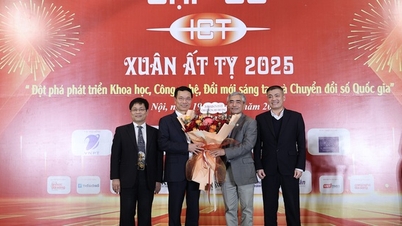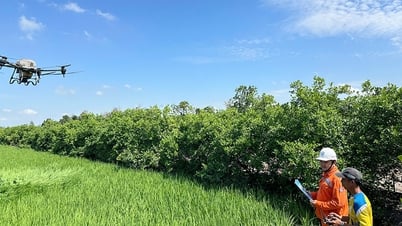VietNamNet Newspaper would like to introduce to readers the speech of Minister of Information and Communications Nguyen Manh Hung, Minister of Information and Communications at the 9th Meeting of the National Committee on Digital Transformation and the Conference to review the first 6 months of 2024 on national digital transformation and Project 06 of the Government.

We have gone through the first 6 months of 2024, the year of digital economic development (DEE) with the pillars of IT and communication industry development, DEE development of industries and localities, Data development as input of DEE and Digital governance development as a new online and data-based governance method. DEE development to create new momentum for the economy, create new competitive advantages for the country.
By the end of the first 6 months of 2024, Vietnam's IT industry is estimated to reach 18.3% of GDP, up 22.4%. Thus, the goal set by the 13th Party Congress, IT industry reaching 20% by 2025, will be achieved.
The IT and communications industry has regained its pre-Covid-19 growth momentum, even higher, with a 26% increase in the first 6 months of 2024 compared to the same period last year. This high increase is partly due to the -5% growth last year, 2023. For the first time, we are drafting a separate law for the development of the IT and communications industry, called the Law on Digital Technology Industry Development (CNS), which is expected to be passed by the National Assembly in 2025.
Vietnam will be one of the few countries with a separate law on the development of the CNS industry, demonstrating the Party and State's interest in the CNS industry as a fundamental industry, the core to promote national industrialization and develop KTS. The CNS industry is the core of KTS. In the early stages of KTS, that is, before 2025, it can account for up to 60% of the KTS, but in the long term, after 2030, it will only account for 40% and then 30% of the KTS.
The development of industrial architects is the convergence of CNS into other industries, such as healthcare, education, agriculture, commerce, banking, etc. The convergence of CNS into other industries is not only to modernize and digitize these industries but also to create new products, services, and new business models, forming the main driving force for the growth of industries. Industrial architects will be the main part of the architects, accounting for up to 70% of the architects.
The Prime Minister has directed that in 2024, each ministry and locality must organize a thematic conference on the development of digital technology in their sector and locality. The Ministry of Information and Communications has issued guidelines on digital technology measurement and digital technology development in localities.
On the development of digital data as a new production factor, as an input for architects. Digital data is a new type of resource. This resource is created by humans using CNS. Normally, when developing, humans consume and exhaust resources. This is the first time in human history that when developing, humans create a new resource, digital data. Digital data must be created, first by state agencies, from central to local levels. The Government has just issued a Decree on the development of national and ministerial databases.
To develop KTS quickly, we must quickly build these databases. The Prime Minister has directed each ministry and locality to have a project like Project 06 of the Ministry of Public Security. These projects should focus on making core data for their industry and locality. Next, data must be bought and sold like goods. This year, the Ministry of Information and Communications will pilot a data trading floor, especially business data.
Regarding digital governance, the Prime Minister is directing the development of an Action Plan on building a Digital Government (CPS) that directs and operates online and based on data. To do this, all ministries and localities must connect online to the Government. Therefore, ministries and localities must also digitally transform their management and operations online and based on data. This will be a fundamental change in digital governance of state agencies, with superiors connecting directly to the IT system of subordinates to obtain data for management, ensuring accuracy and timeliness, and no longer requiring subordinates to report data to superiors in writing. After this Plan is issued, there will be a guide for ministries and localities to develop their own action plans.
Without local digital transformation, there will be no digital transformation at the ministerial level, and without digital transformation at the ministerial level, there will be no digital transformation at the government level. This action plan has many things to do, but there is only one thing that determines all the rest: the daily activities of civil servants from the lowest level in the government system must be carried out in the digital environment, or else they must be entered into the system periodically. Therefore, the most important thing about digital transformation is that the government levels must institutionalize and have regulations on working in the digital environment and data entry for each civil servant.
Once fully digitized, analyzing, evaluating, detecting problems, and changing the operation of the system will be just software, a matter of technology. The Government's action plan for online and data-based direction and administration focuses on 2024-2025, but has an orientation towards 2030.
In addition to developing KTS, I would like to add the following 3 ideas.
Firstly, in June 2024, the National Committee on Digital Transformation held a conference on successful digital transformation models at the ministerial level for replication at the Supreme People's Court. In the third quarter, the Committee will hold two more conferences on online public service models and smart operation center models at the provincial level. After many years of digital transformation, we have just summarized successful models for replication. We recommend that ministries, branches and localities refer to successful models to promote digital transformation at their level.
Second, regarding AI applications: AI acts as an assistant, helping humans, not surpassing humans. Even though AI is smarter, has more information, and more knowledge, it is still to help humans make decisions and work better. The most effective application of AI, the easiest to do, and can be done quickly is the virtual assistant (TLA). It can be done quickly because the technology platform is ready, each unit only needs to put its knowledge system into TLA and train it, usually within 3-6 months. The effectiveness is because each civil servant (CBCC) will have one more assistant.
This virtual assistant is particularly proficient in legal documents, regulations, procedures, and methods, which are things that our civil servants are having a hard time with because the legal system is too large and difficult for anyone to remember and master. The Ministry of Information and Communications will have guidelines on TLA development in the third quarter for ministries, branches, and localities to refer to and implement, based on the implementation practices at the Ministry of Information and Communications.
Third, on training in digital transformation for leaders at all levels. In digital transformation, Transformation is the main noun, Number is an adjective, and digital technology is just a tool to carry out the transformation. Digital transformation is comprehensive digitalization and then changes the way the organization operates. If the leader does not directly participate, does not directly direct, does not directly do, does not directly use, does not directly transform himself, it will not be successful.
Source


![[Photo] Prime Minister Pham Minh Chinh chairs conference on anti-smuggling, trade fraud, and counterfeit goods](https://vphoto.vietnam.vn/thumb/1200x675/vietnam/resource/IMAGE/2025/5/14/6cd67667e99e4248b7d4f587fd21e37c)



































































































Comment (0)